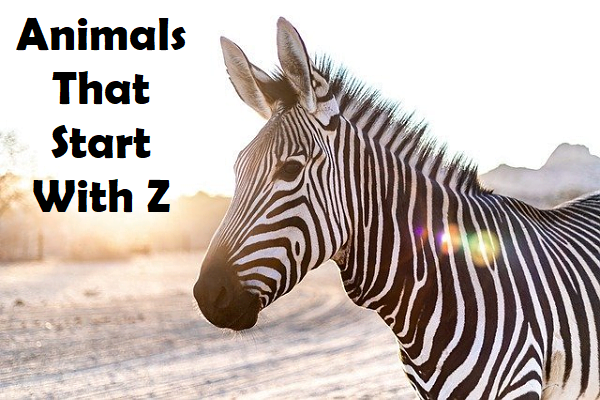On this page, you’ll discover a rundown of astonishing creatures starting with z, along with intriguing realities about every creature. Underneath a significant number of the creatures are joined that you can follow for additional data, pictures, and recordings.
Remembered for this rundown are singular species (for example zebra duiker) and notable gatherings of species (for example zorros) whose names start with Z. The logical name and preservation status are accommodated every one of the individual animal groups.
Find creatures starting with Z and attempt to think about their individual trademark qualities and where they are found. This ordered rundown is best for youngsters who are attempting to learn in the Animalia realm.
Creatures That Starts With The Letter ‘Z’

Zebra
Zebras are individuals from the pony family Equidae. There are three types of zebra: the fields zebra, mountain zebra, and Grévy’s zebra. All have unmistakable highly contrasting stripes, the example of which are interesting to every person.
The field zebra is the commonest and most broad zebra; the jeopardized Grévy’s zebra is the world’s biggest wild pony species.
Preservation Status of Zebra Species
Plains zebra: Near Threatened
Mountain zebra: Vulnerable
Grévy’s zebra: Endangered
Zebra Duiker
Scientific Name: Cephalophus zebra
Conservation Status: Vulnerable
The zebra duiker is a little impala found in the West African nations of Liberia, Ivory Coast, Sierra Leone, and Guinea. The species has an earthy-colored coat with zebra-like highly contrasting stripes on its rump.
Zebra duikers live in rainforests. The species’ protection status is vulnerable. The fundamental dangers to its endurance are deforestation and being pursued by local people for bushmeat.
Zebrafish/Zebra Danio
Scientific Name: Danio rerio
Conservation Status: Least Concern
The zebrafish is a little Asian freshwater fish. It is found in the southeastern Himalayan area and lives in streams, lakes, and different waterways. It’s not difficult to perceive how the species got its name: the stripes running along its sides look like those of a zebra.
The zebrafish is utilized in clinical exploration because of its regenerative capacities; the species can re-develop its balance, skin, heart, and other body parts during its larval stage.
Zokor
Zokors are burrowing rats found in China, Kazakhstan, and Russia. The six types of zokor make up the subfamily Myospalacinae.
Zokors take after and are identified with, daze mole rodents. Dissimilar to daze mole rodents, who burrow with their teeth, zokors utilize their paws. Zokors are covered with short fur and have no outer ears.
Zorilla (Striped Polecat)
Latin name: Ictonyx striatus
Type: Mammal
Diet: Carnivore
Normal life expectancy: Up to 13 Yrs (in Captivity)
Length 28 – 38 cms (11 – 15 inches)
Tail 20 – 30 cms (8 – 12 inches)
Weight: 1.5 Kgs (3.25 lbs)
Conservation Status: Least Concern
The zorilla is an individual from the weasel family Mustelidae that is found all through quite a bit of sub-Saharan Africa (for example the piece of the mainland south of the Sahara Desert.
Skunk-like apparently, the zorilla has dim earthy colored fur set apart with light stripes running from its head to its tail. It is exceptionally forceful and regional.
The zorilla is a lone hunter. It goes after an assortment of little creatures, including rodents and reptiles. The striped polecat is nocturnal and is subsequently not frequently experienced. It is a singular creature and searches for little warm-blooded animals, creepy crawlies, insects, birds’ eggs, and some of the time snakes or poultry.
When out searching, it jogs alongside its back marginally slouched and its tail held out evenly: pushing ahead intentionally, it sticks its gag into free litter searching for its prey. The Striped Polecat youthful, generally a few to a litter, are altricial: they are conceived visually impaired, bare and pink.
Zorro
Zorro is the Spanish name for types of the family Lycalopex, also called the South American Foxes.
Zorros are false foxes and are all the more firmly identified with wolves and jackals. (The ‘genuine foxes are of the family Vulpes.) There are six types of zorro.
They incorporate the culpeo, which is the second-biggest individual from the canine family (Canidae) in South America, and the imperiled Darwin’s fox.
Zebu
Scientific Name: Bos Primigenius Indicus
Type: Mammal
Diet: Herbivore
Size: 86-106cm (34-42in)
Weight: 150-200kg (331-440lbs)
Maximum velocity: 40km/h (25mph)
Life expectancy: 12-16 years
Group Name: Herd
The Zebu is the lone dairy cattle species that can undoubtedly adjust to life in the hot jungles. The zebu is otherwise called the bumped steers as the zebu has an extremely particular mound on its upper back, situated behind the head and neck of the zebu.
The zebu is probably the littlest species of steers on the planet with grown-up zebus arriving at the height of a little more than a meter. The zebu is likewise about a large portion of the heaviness of a common cow as the zebu is considered to have less meat.
The little size of the zebu is believed to be the motivation behind why the zebu can flourish in heat and humidities, where different types of cows don’t reasonably so well.
Zenaida dove
The Zenaida dove (Zenaida aurita) is an individual from the bird family Columbidae, which incorporates birds and pigeons. It is the national bird of Anguilla, where it is privately given the name of “turtle dove”.
The Zenaida Dove is around 28–30 cm (11–12 in) long. It looks basically the same as the grieving pigeon, yet is more modest in size, has a more limited, more adjusted tail, and is somewhat more hazily colored.
It is likewise recognized by the grieving bird by showing white on the following edge of its wings while in flight. The grieving pigeon doesn’t have the white following edge.
It lays two white eggs on an unstable stage, based on a tree or bush. It likewise settles in a rock cleft, and on lush vegetation, if no hunters are available. It has been recorded that a few birds have up to 4 broods each year.
